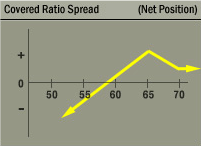Covered Ratio Spread
This strategy profits if the underlying stock moves up to, but not above, the strike price of the short calls.
Description
This strategy consists of being long stock, short two calls at one strike and long a call at a higher strike. All the options must have the same expiration date.
Outlook
Looking for a slight rise in the stock price.
Summary
This strategy profits if the underlying stock moves up to, but not above, the strike price of the short calls. Beyond that, the profit erodes and then hits a plateau.
Motivation
Earn additional income while holding a long stock position. This is a classic option strategy for lowering the breakeven level of a long stock position that is underwater.

EXAMPLE
- Long 100 shares stock
- Short 2 65 calls
- Long 1 70 call
MAXIMUM GAIN
- Lower call strike - stock purchase price + net premium received
MAXIMUM LOSS
- Stock purchase price - net premium received (substantial)
Variations
N/A
Max Loss
The maximum loss would occur should the stock become worthless. In that case, the investor would have lost the entire value of their stock. That loss, however, would be reduced by the premium received from initiating the option strategy.
Max Gain
The maximum gain would occur should the underlying stock be at the strike price of the short calls. In that case, all the options would expire worthless, and the investor could pocket the premium received for initiating the option strategy in addition to the profit from the stock's appreciation.
Profit/Loss
The potential profit (from the options) is limited. Potential losses are substantial. However, the maximum loss results from the investor's stockholding, not the options. Any loss resulting from this strategy would always be less than a loss resulting from simply purchasing the same amount of stock at the initial position entry date.
Breakeven
This strategy breaks even if at expiration the underlying stock has fallen by the amount of premium received for initiating the strategy.
Volatility
An increase in implied volatility, all other things equal, would have a negative impact on this strategy.
Time Decay
The passage of time, all other things equal, will have a positive effect on this strategy.
Assignment Risk
Yes. However, the investor is already covered on one of the short calls. And while the call options can be exercised at any time, it is usually not optimal to exercise a call early unless there is a dividend payment. Should the investor be assigned on both short calls, exercising the long call to cover one of the assignments would require being short the underlying stock for one business day.
And be aware, a situation where a stock is involved in a restructuring or capitalization event, such as a merger, takeover, spin-off or special dividend, could completely upset typical expectations regarding early exercise of options on the stock.
Expiration Risk
Yes. Should an assignment at expiration occur or not occur unexpectedly, the investor could find themselves with a position on the Monday following expiration and subject to an adverse move over the weekend.
Comments
This strategy is often used by an investor to lower their breakeven point on a long stock position. To the extent that a credit is received for initiating the position, it can also serve as a hedge.
Related Position
Comparable Position: N/A
Opposite Position: N/A

